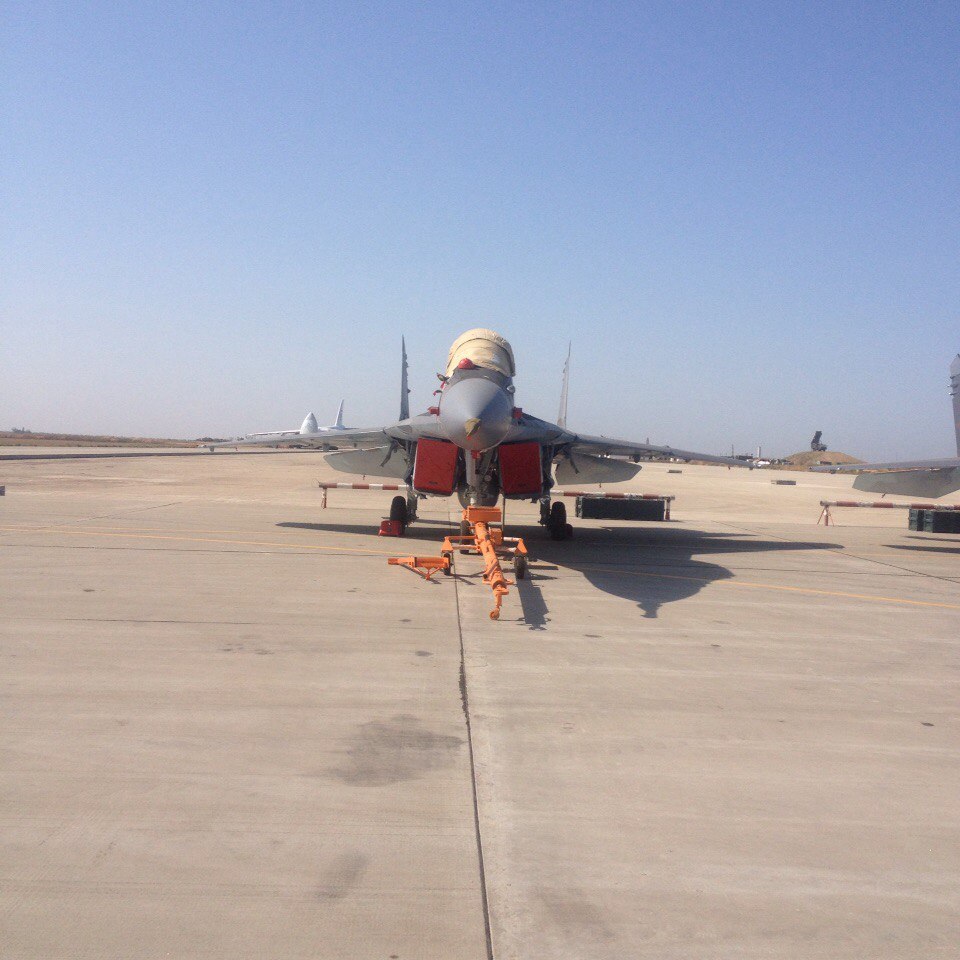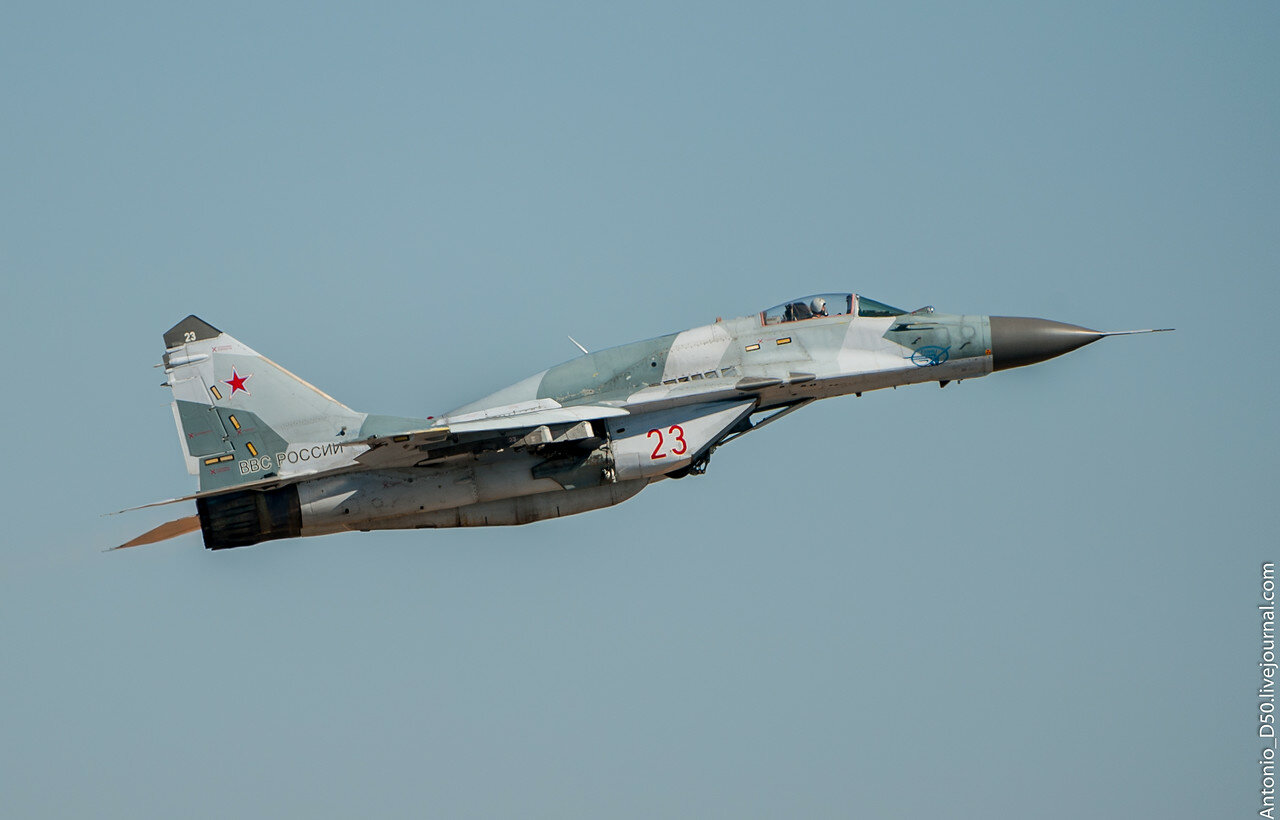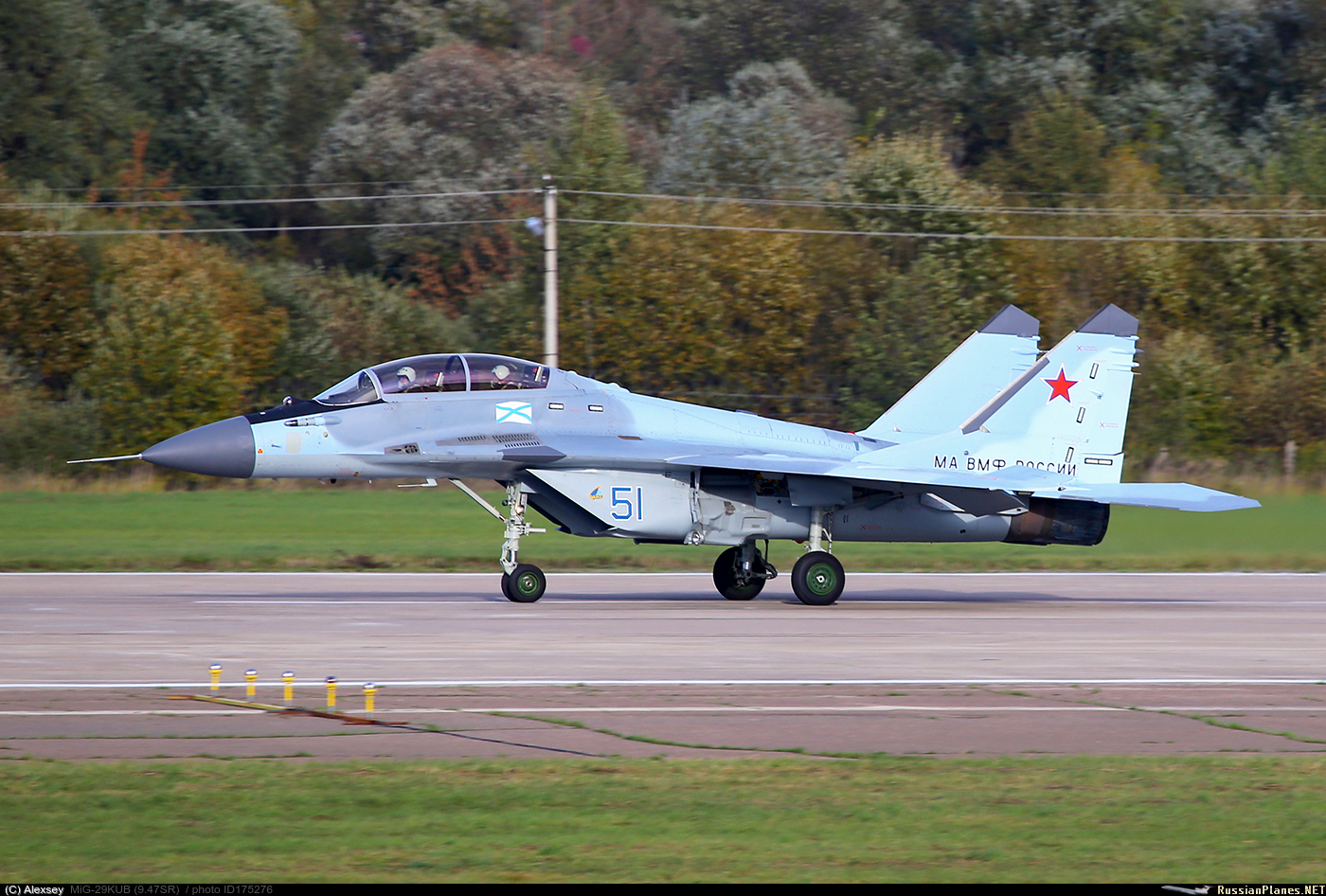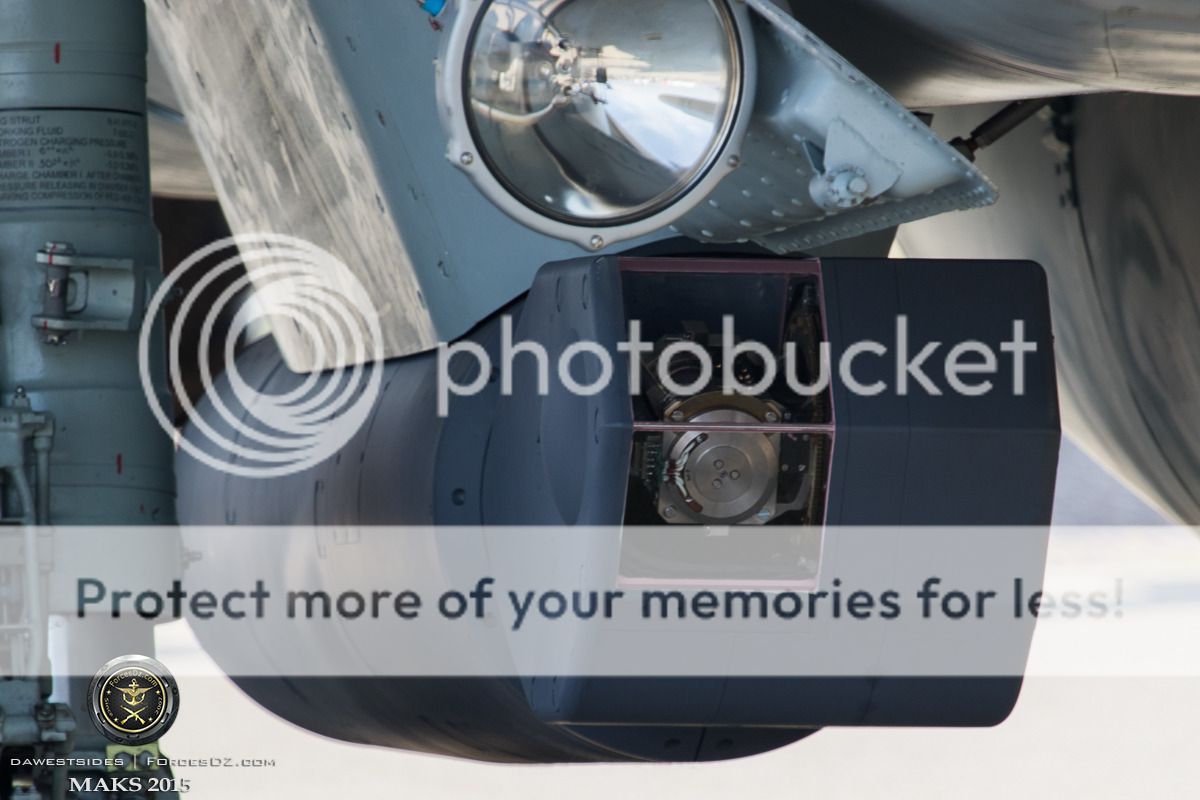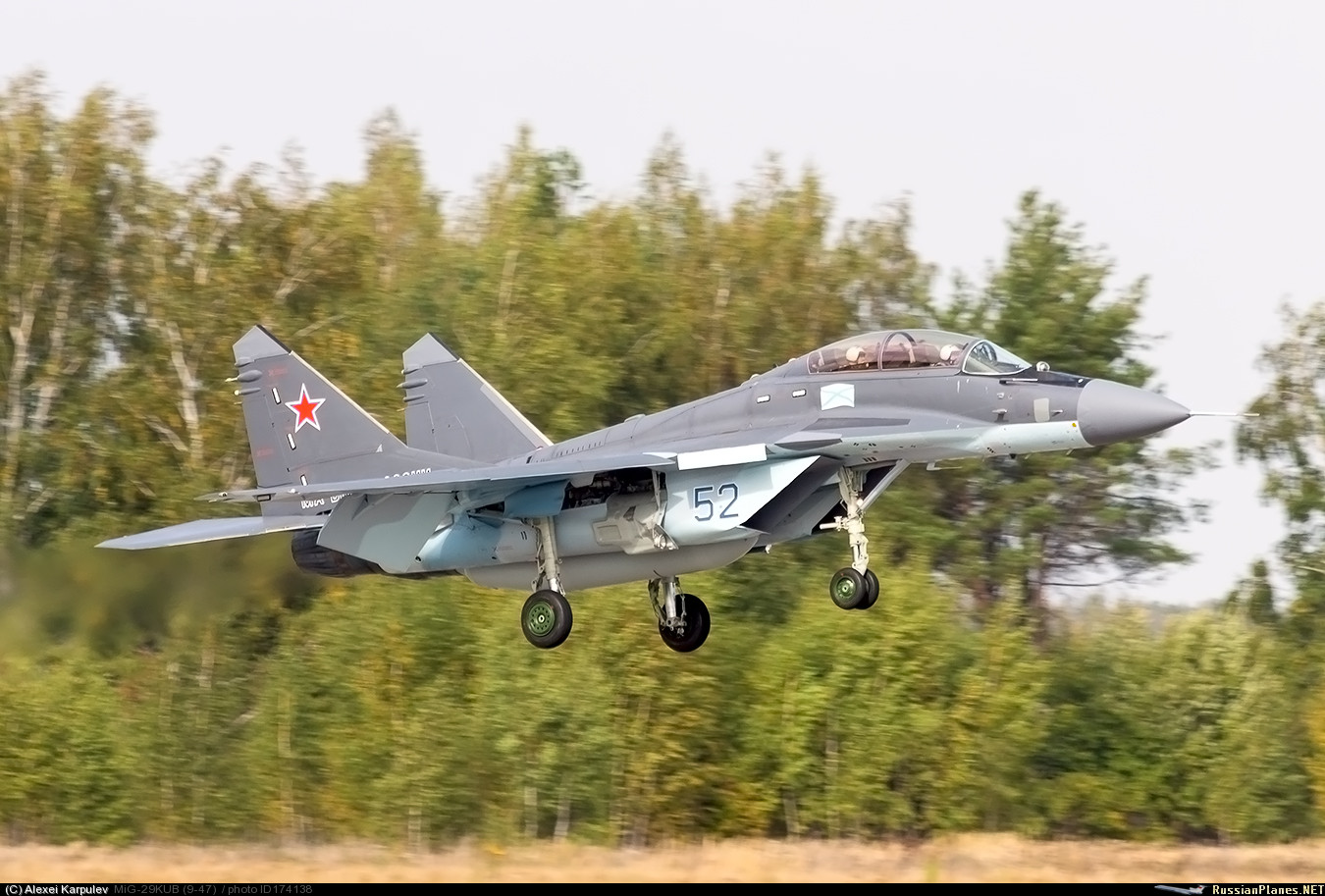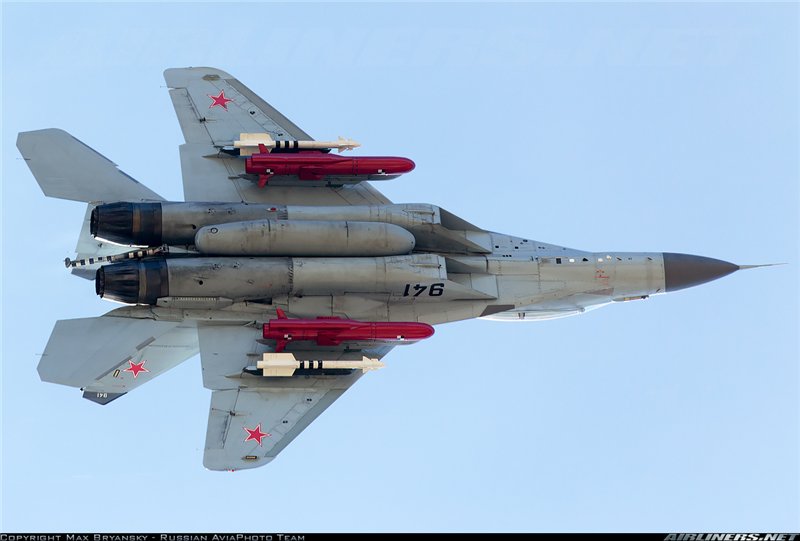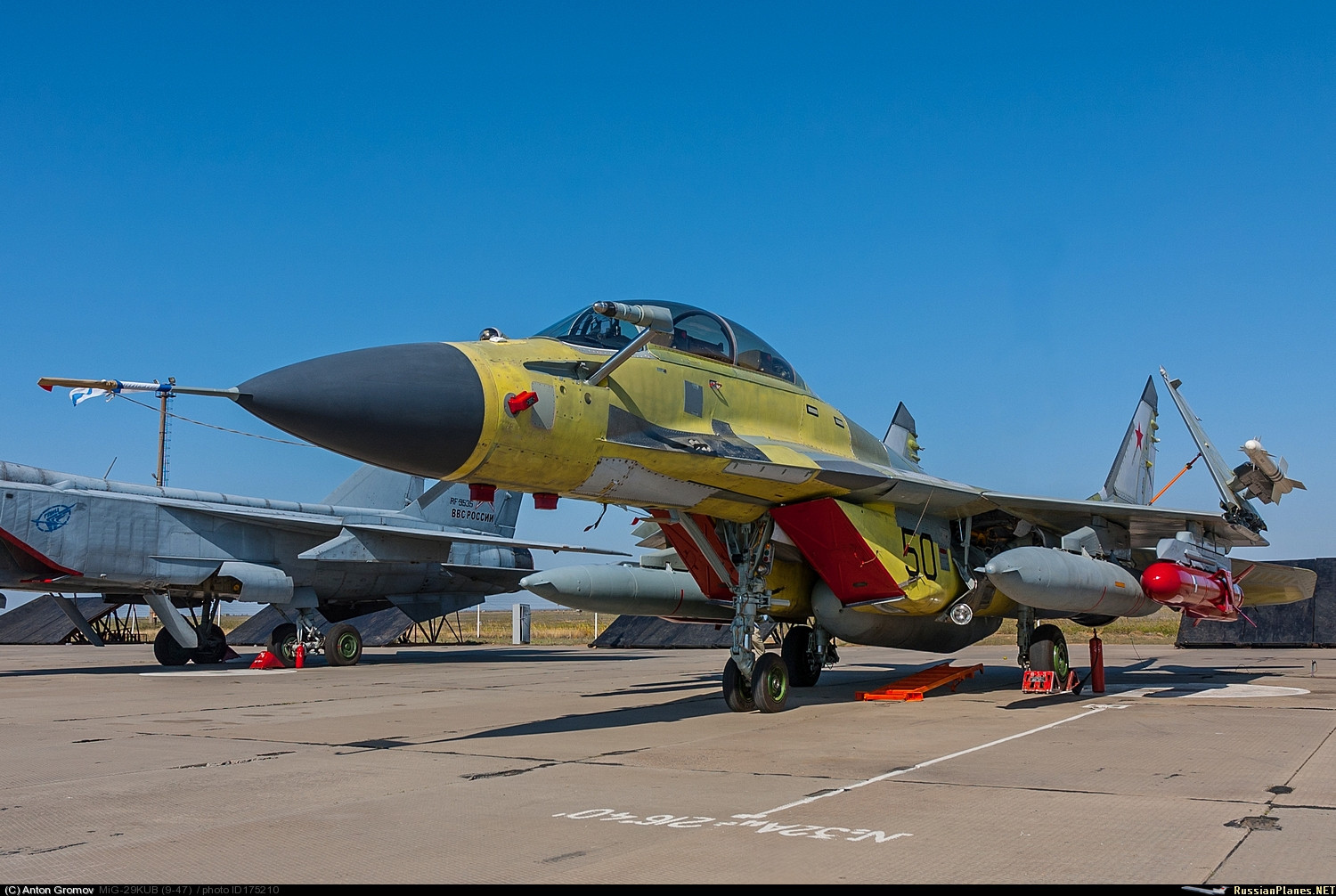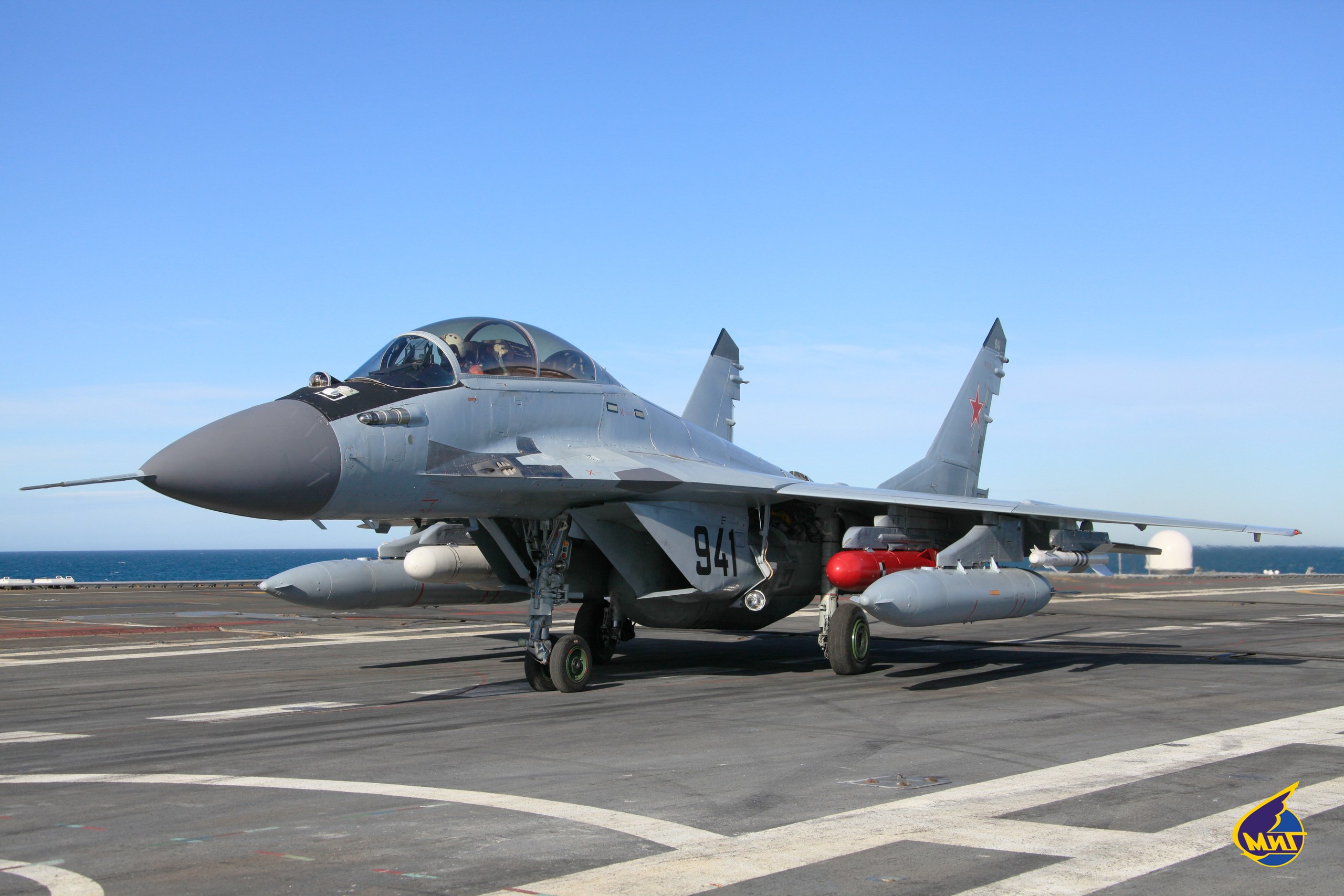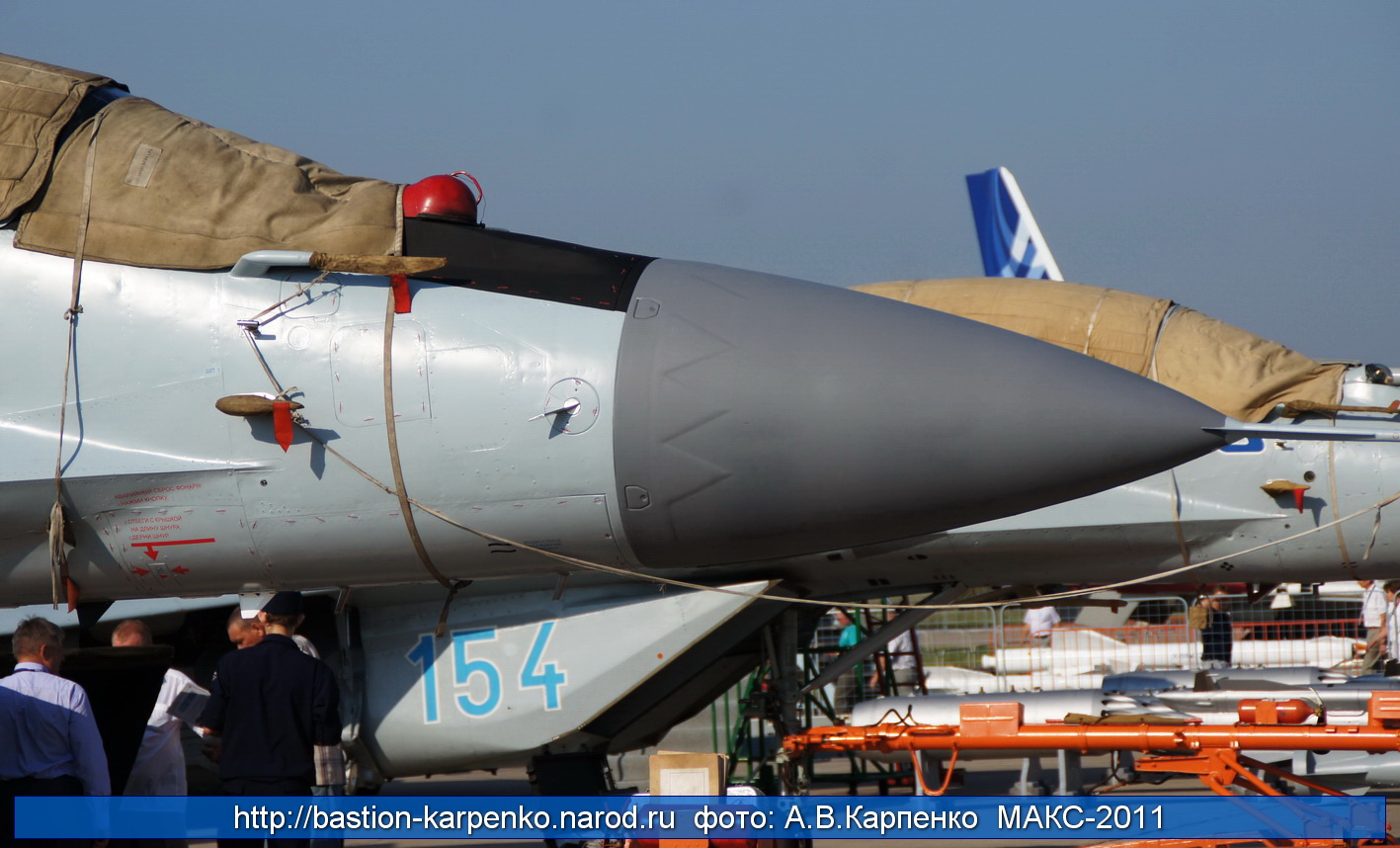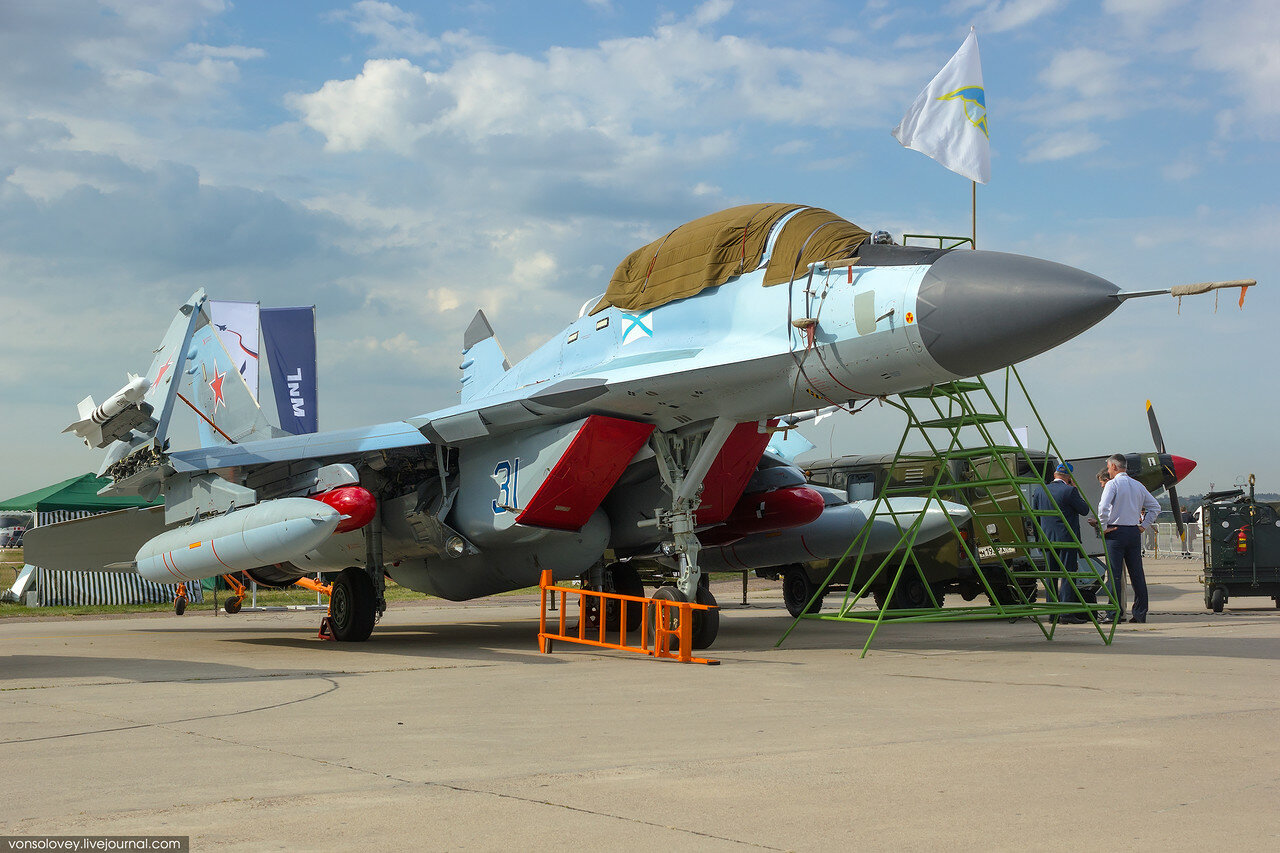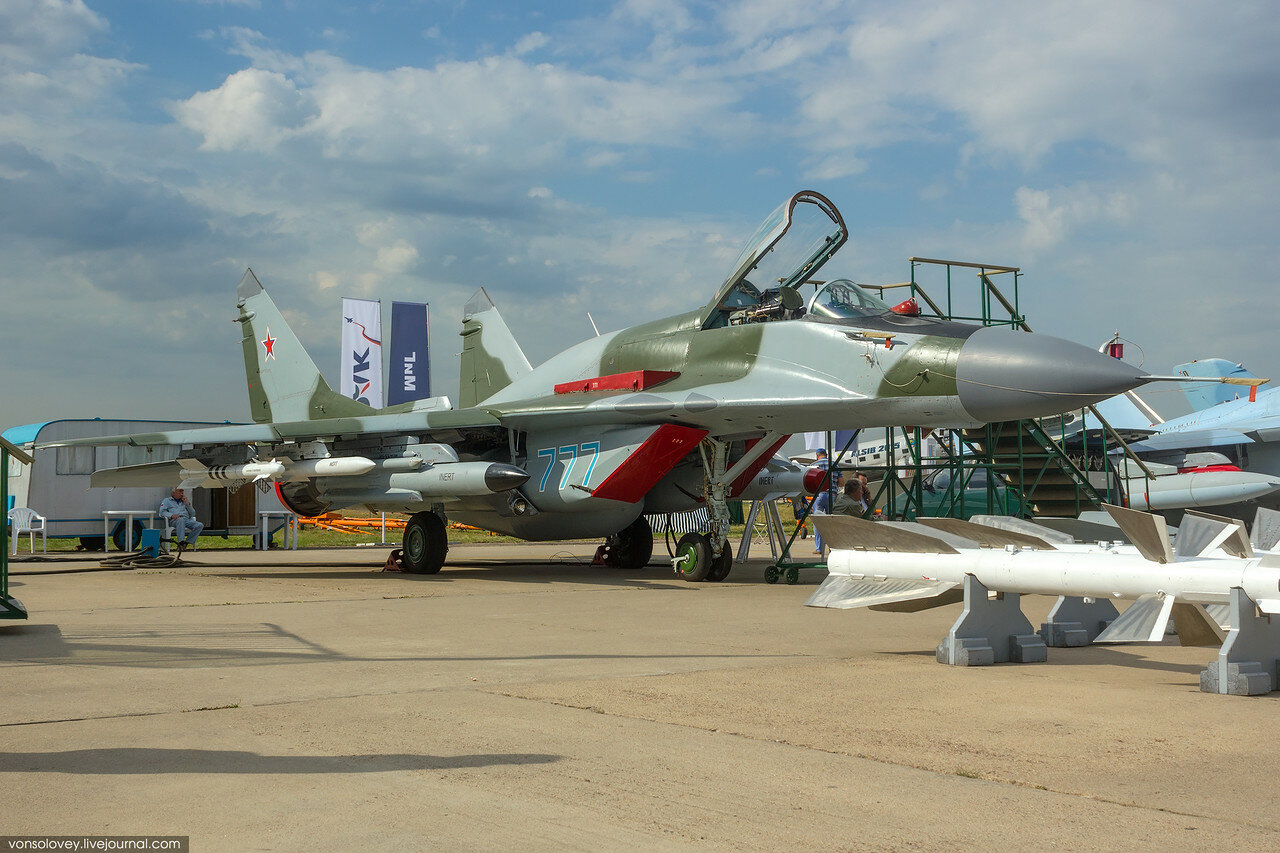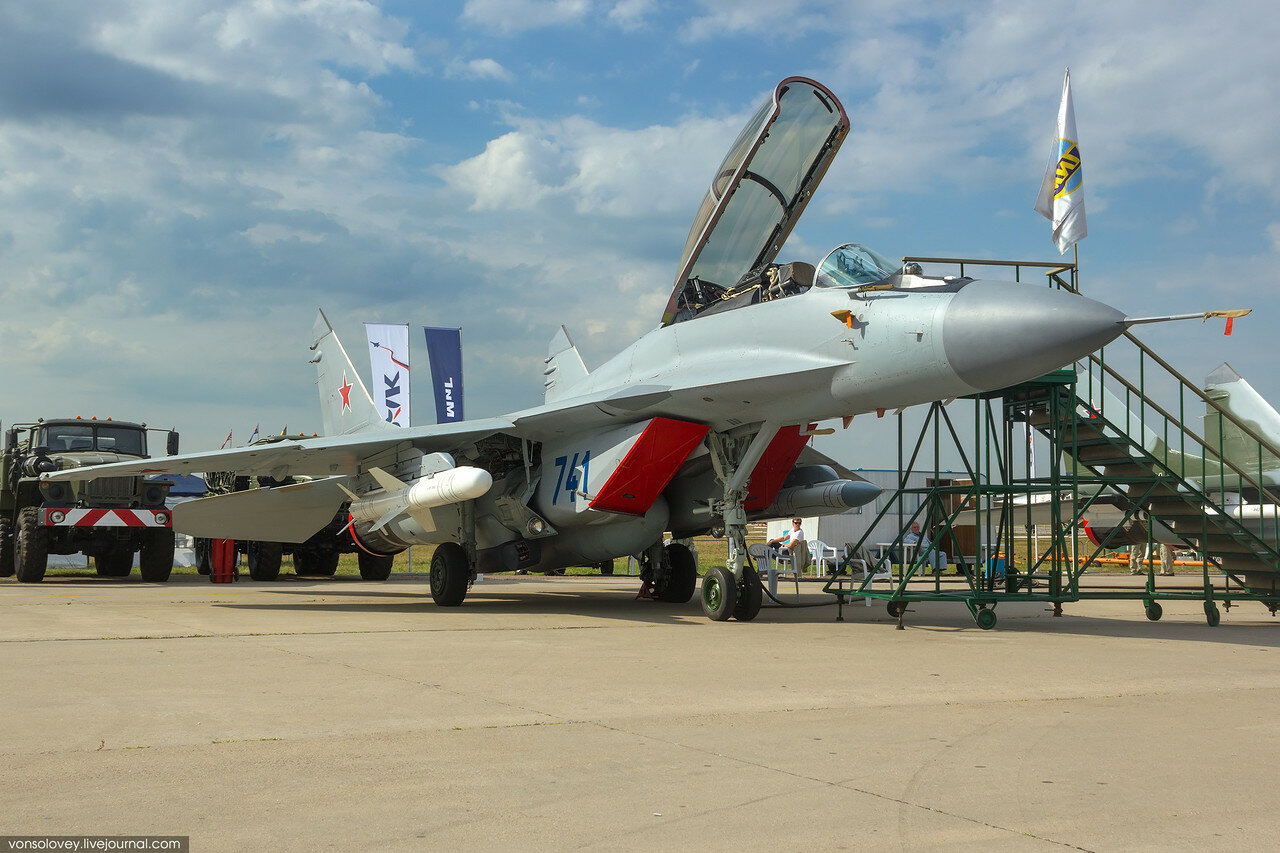MiG-29/35 Fulcrums
- Thread starter gadeshi
- Start date
More options
Who Replied?gadeshi
New Member
- Joined
- Jun 19, 2013
- Messages
- 9,223
- Likes
- 6,636
The first play from the first new order batch of MiG-29SMT/UBT for VKS Erebuni AB in Armenia - MiG-29UBT (9-53):
http://dmitrij-uwgg.livejournal.com/5679.html


http://dmitrij-uwgg.livejournal.com/5679.html


- Joined
- Oct 13, 2015
- Messages
- 7,494
- Likes
- 17,197
Before the induction of MIG 29 IAF never had any long range true air superiority fighter thus pakistan had the edge with their F 16 against our point defence mig 21 So mig 29 will always have a special place in our hearts.It also locked paki F 16 during kargil war with superior R 77.
gadeshi
New Member
- Joined
- Jun 19, 2013
- Messages
- 9,223
- Likes
- 6,636
And now India has its own MiG-29SMT - MiG-29UPGBefore the induction of MIG 29 IAF never had any long range true air superiority fighter thus pakistan had the edge with their F 16 against our point defence mig 21 So mig 29 will always have a special place in our hearts.It also locked paki F 16 during kargil war with superior R 77.
- Joined
- Oct 13, 2015
- Messages
- 7,494
- Likes
- 17,197
By Russian standards, the MiG-29 canopy has a superb view outside. Earlier aircraft were designed with minimal glass area, with no rear view and restricted side view. The doctrine was that pilots would be guided by GCI - Ground Controlled Intercepts, so they won't need to rely on visual flying.
But the need for dog fighting meant better situational awareness, that meant better view of the surroundings. So like western designs of the time, the MiG-29 (and Su-27) was/were designed with a bubble canopy with a good view.
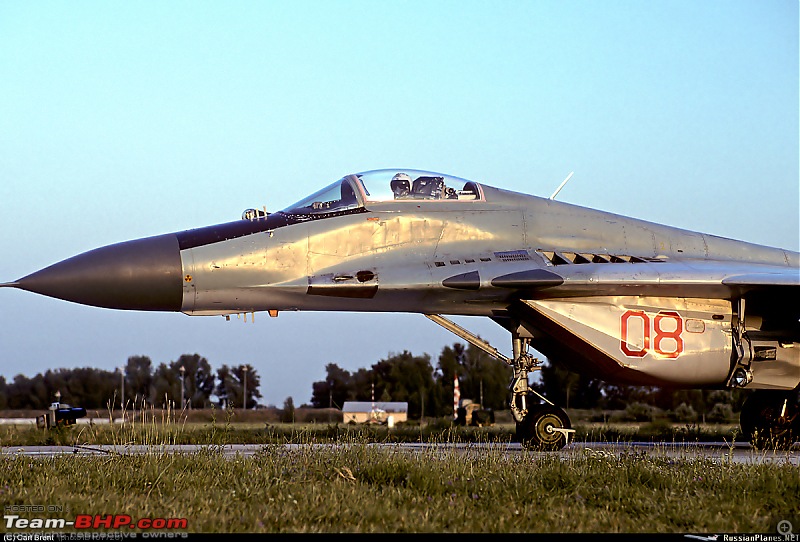
Is that a sensor, or a work of art in metal sculpture?
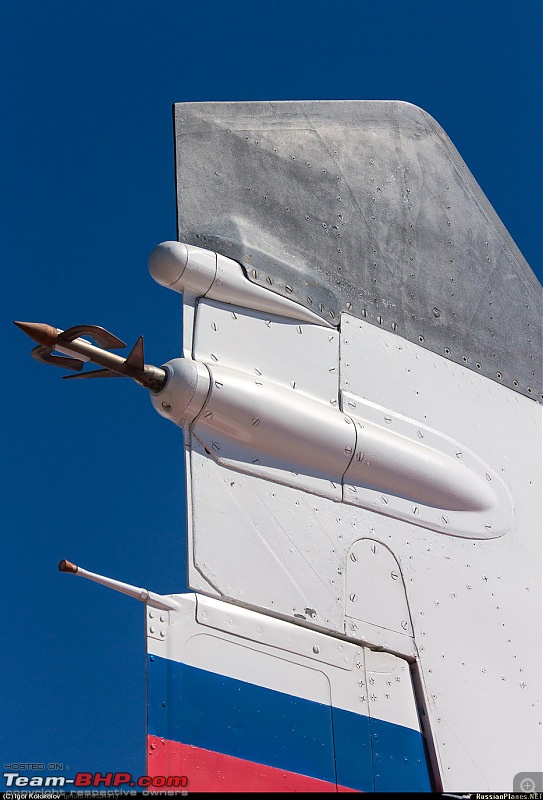
The MiG-29UB's smaller nose betrays absence of radar.
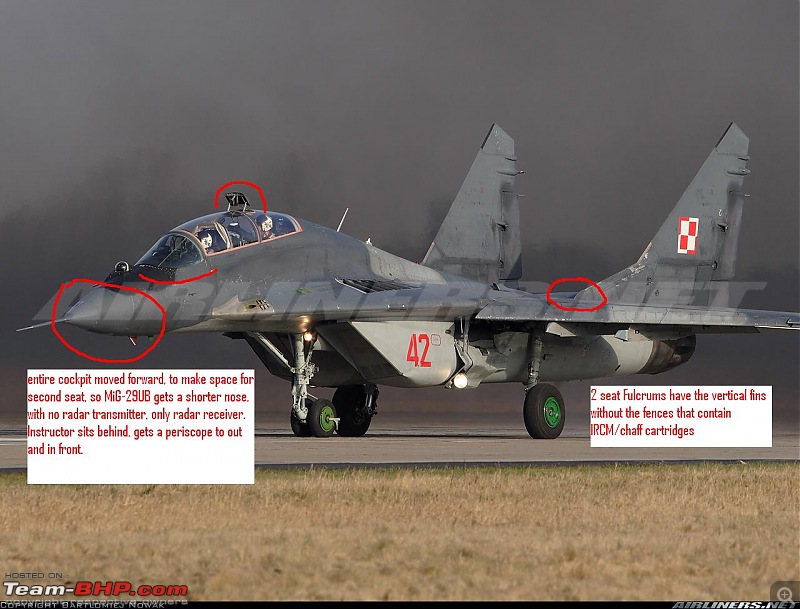
The UB trainer variant has a periscope for the instructor, who sits in the rear seat, to get a view of what's in front.
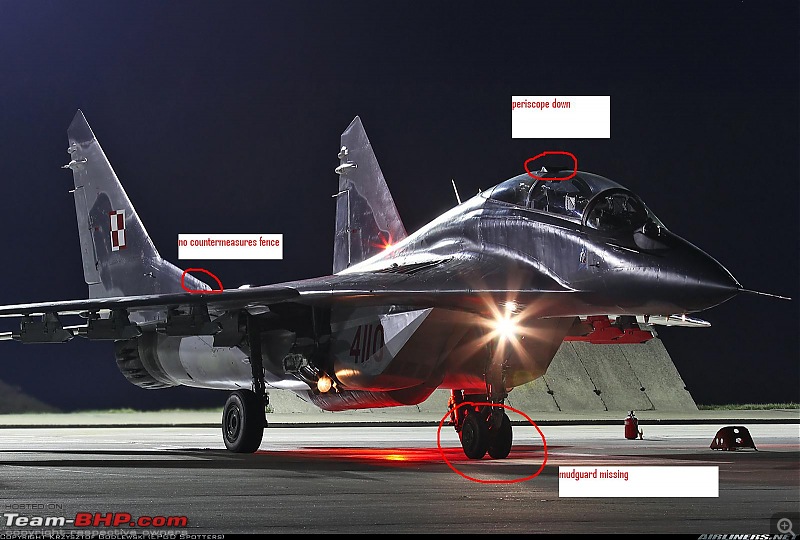

But the need for dog fighting meant better situational awareness, that meant better view of the surroundings. So like western designs of the time, the MiG-29 (and Su-27) was/were designed with a bubble canopy with a good view.

Is that a sensor, or a work of art in metal sculpture?

The MiG-29UB's smaller nose betrays absence of radar.

The UB trainer variant has a periscope for the instructor, who sits in the rear seat, to get a view of what's in front.


- Joined
- Oct 13, 2015
- Messages
- 7,494
- Likes
- 17,197
Here's a view of the intake grille/louvres on the upper LERX surface, that the engines breathe through when main intake doors are closed.
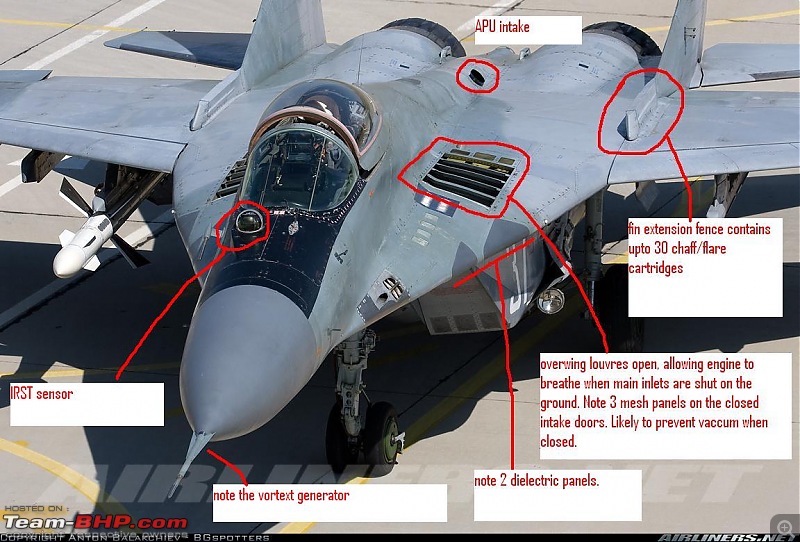
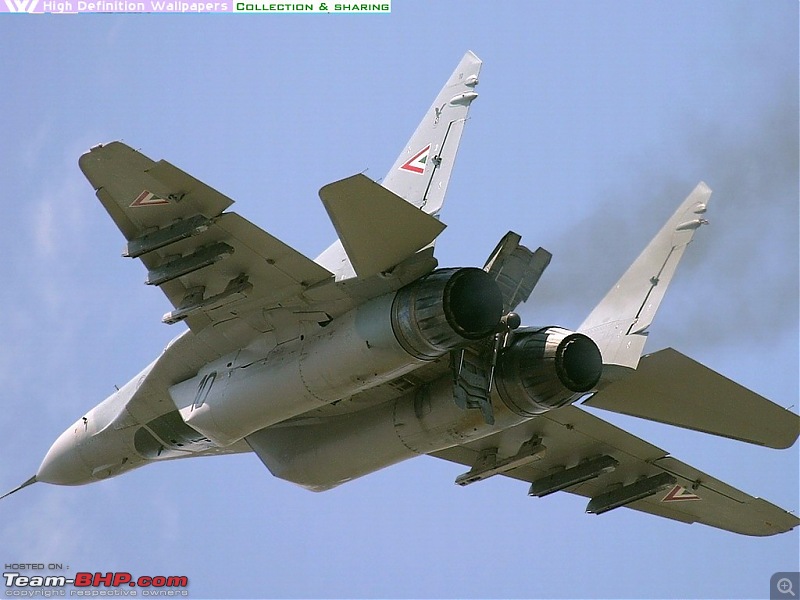
The airbrake on the older variants, in extended position.
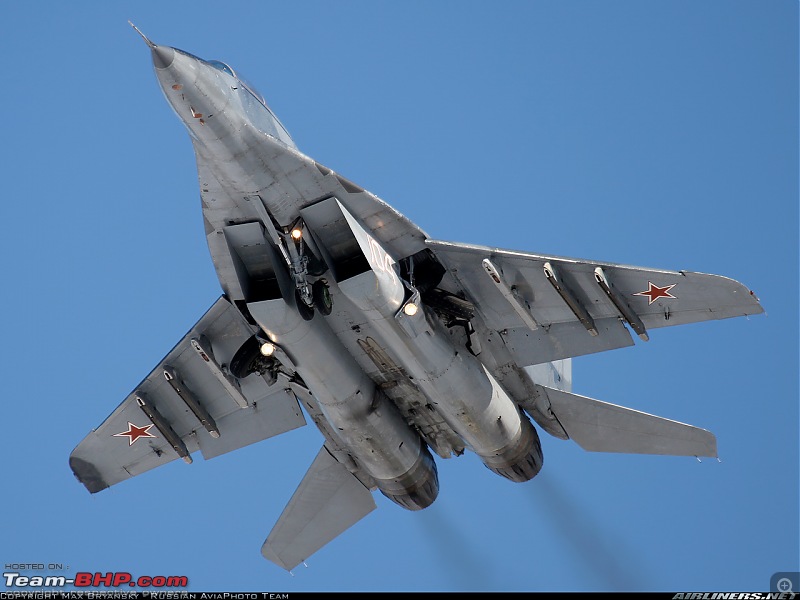
Wheels retract and rotate to lie flat, parallel to ground, within the wing root.
Tail cone of the MiG-29KUB/M2 is different, so is the nose cone! The MiG-29M2/KUB/35 utilizes the same front section as the single seater , instead raising the section behind the cockpit and elongating it to fit the second crew. It does cause more drag, but loses relativeless less volume for fuel/equipment.
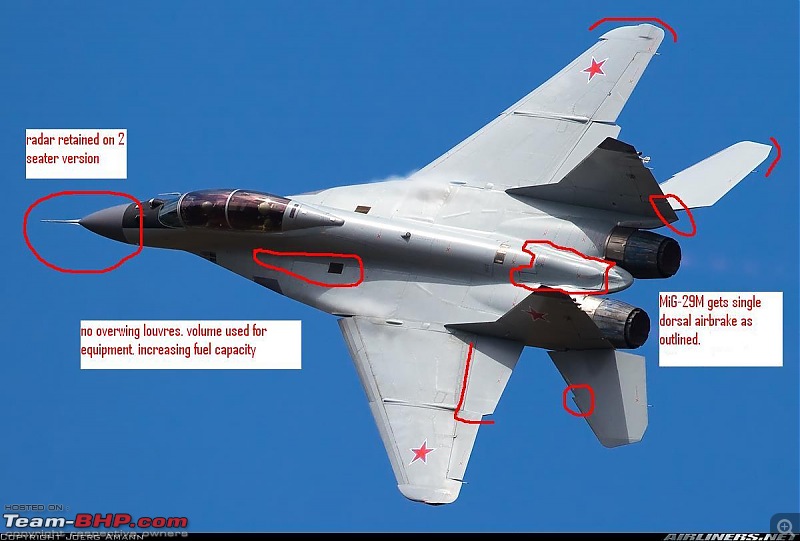
The heart of the jet - the Klimov RD33 turbofan.

Engines are started one at a time.

Typically the left, and in emergencies, the aircraft can taxi out on one engine alone.
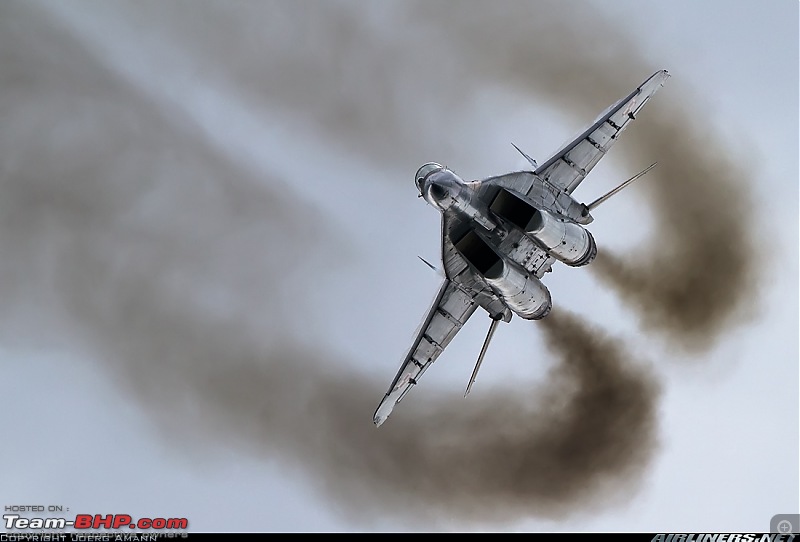
One of the characteristics of the RD-33, is the copious amount of smoke it emits on throttle transition.
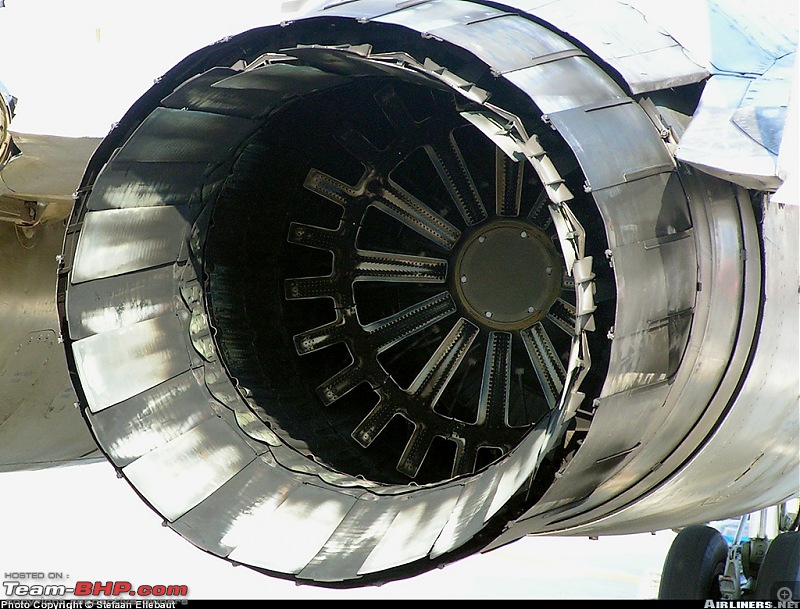
The exhaust nozzle in detail. The individual petals are informally called turkey feathers, because of their resemblance to overlapping bird feathers.
Here, you can see the differences in the wing design between the older A/B/C Fulcrum models, and the modernized K/M1/M2/MiG-35 models.


The airbrake on the older variants, in extended position.

Wheels retract and rotate to lie flat, parallel to ground, within the wing root.
Tail cone of the MiG-29KUB/M2 is different, so is the nose cone! The MiG-29M2/KUB/35 utilizes the same front section as the single seater , instead raising the section behind the cockpit and elongating it to fit the second crew. It does cause more drag, but loses relativeless less volume for fuel/equipment.

The heart of the jet - the Klimov RD33 turbofan.

Engines are started one at a time.

Typically the left, and in emergencies, the aircraft can taxi out on one engine alone.

One of the characteristics of the RD-33, is the copious amount of smoke it emits on throttle transition.

The exhaust nozzle in detail. The individual petals are informally called turkey feathers, because of their resemblance to overlapping bird feathers.
Here, you can see the differences in the wing design between the older A/B/C Fulcrum models, and the modernized K/M1/M2/MiG-35 models.
- Joined
- Oct 13, 2015
- Messages
- 7,494
- Likes
- 17,197
The legacy Fulcrums (A/B/C).
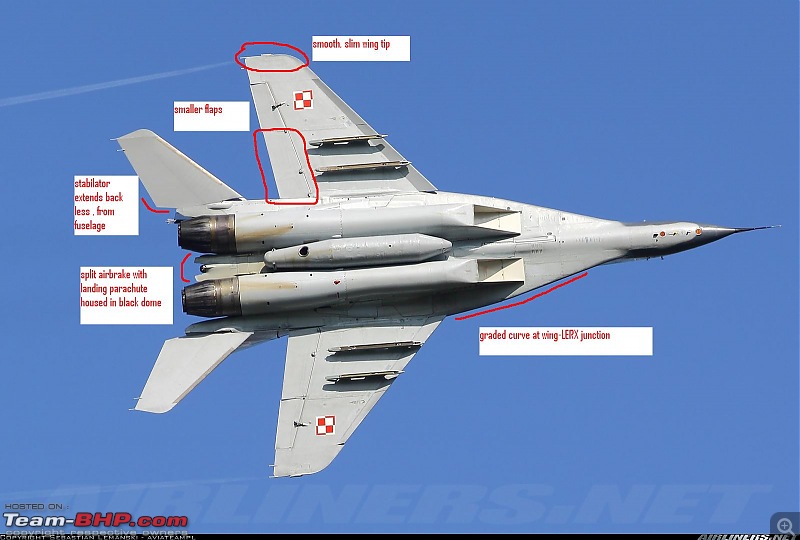
And the modern Fulcrums.
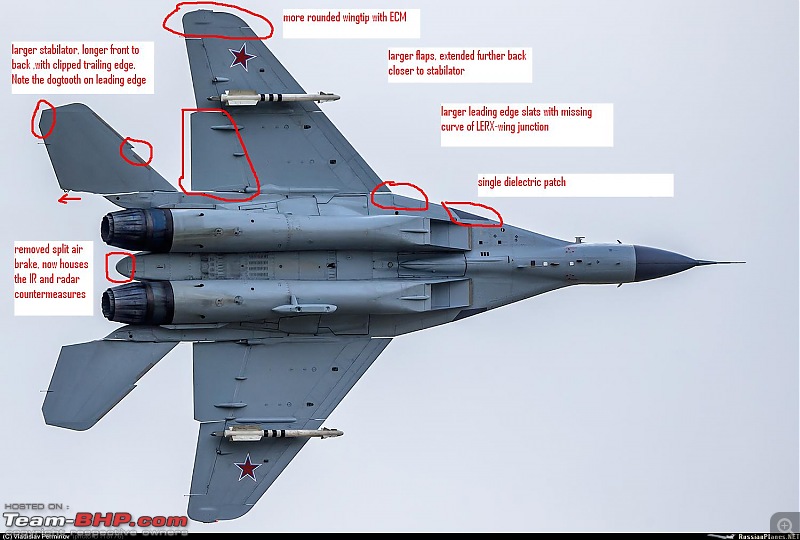
The legacy Fulcrums (A/B/C).
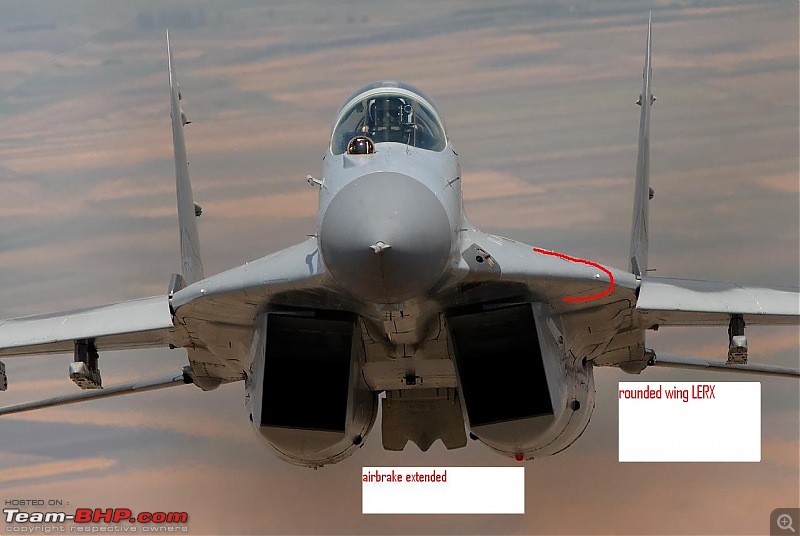
And the modern Fulcrums.

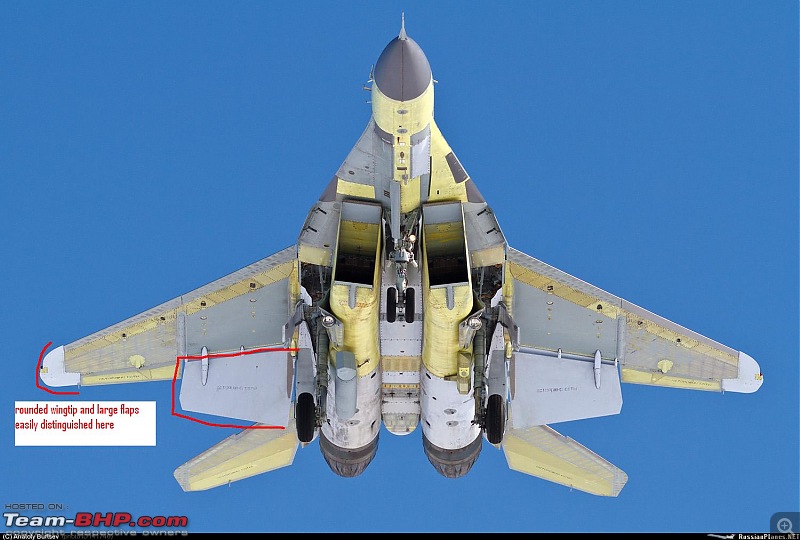
The larger flaps on the MiG-29K/M/35 are very prominent, as can be seen above.
MiG-29K with buddy refuelling pack.
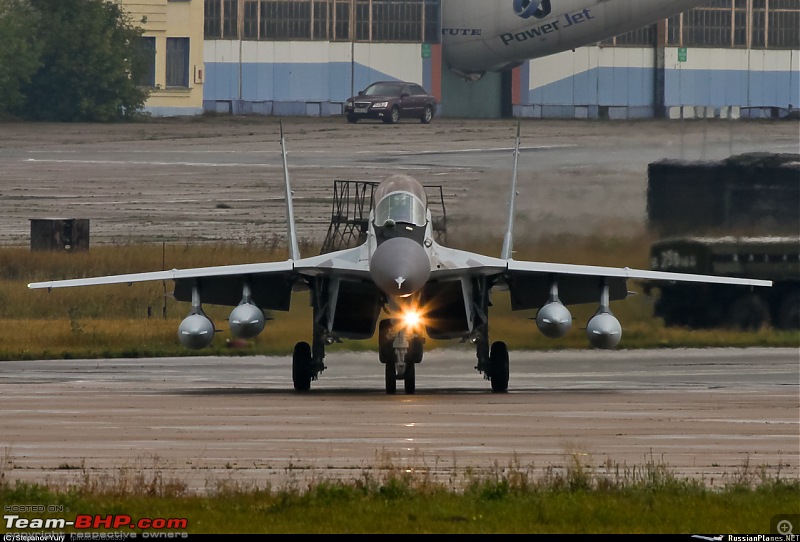
See those vortices forming at the LERX ?
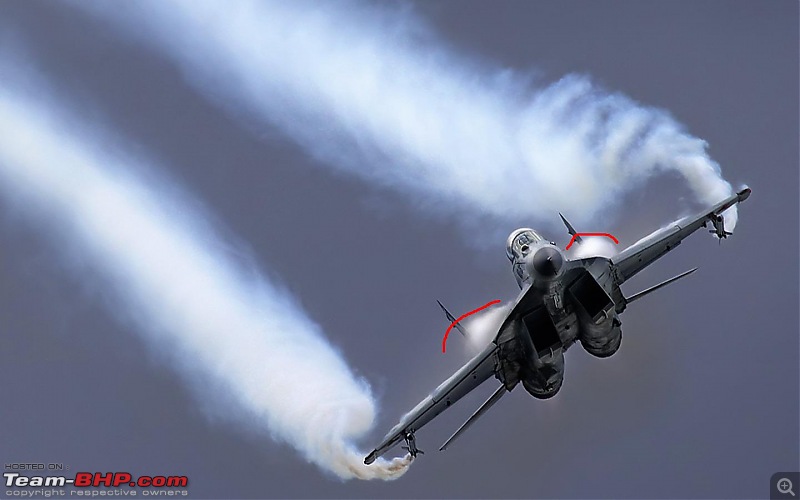
The MiG-29 releases a parachute after touching down, to decelerate. It not only reduces brake wear, it also reduces risk of slipping on icy runways.
The newer MiG-29M1/M2 and MiG-35 have 2 parachutes instead of a single large one, ostensibly because a larger diameter chute would simply drag on the runway.
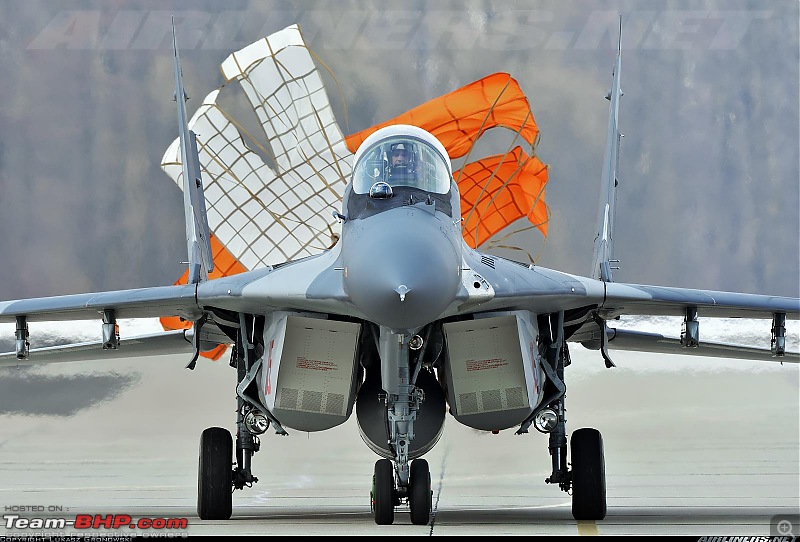

And the modern Fulcrums.

The legacy Fulcrums (A/B/C).

And the modern Fulcrums.


The larger flaps on the MiG-29K/M/35 are very prominent, as can be seen above.
MiG-29K with buddy refuelling pack.

See those vortices forming at the LERX ?

The MiG-29 releases a parachute after touching down, to decelerate. It not only reduces brake wear, it also reduces risk of slipping on icy runways.
The newer MiG-29M1/M2 and MiG-35 have 2 parachutes instead of a single large one, ostensibly because a larger diameter chute would simply drag on the runway.

- Joined
- Oct 13, 2015
- Messages
- 7,494
- Likes
- 17,197
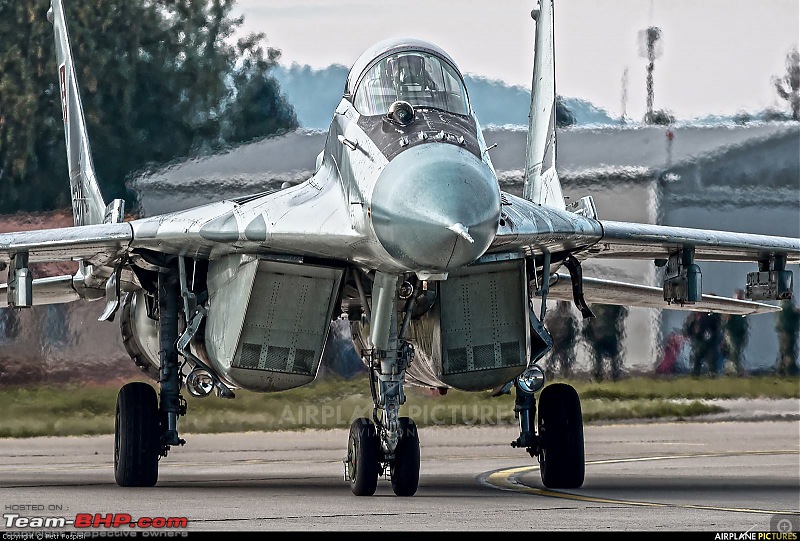
As I walked around the MiG, it was growing on me. Those huge gaping intakes, that massive exhaust nozzle. I could crawl inside one!

One hot sultry day in May 1989 changed everything for me.
Meet the Mikoyan Gurevich MiG-29. NATO christened it the "Fulcrum".
Taking to the air for the first time ever, on 6 October 1977, the MiG-29 was the smaller of the TsAGI twins. TsAGI is the Russian aero and hydrodynamics research institute, somewhat of a smaller NASA you might say. The Soviets had already for the news of the new American teen series , how powerful and agile they were, and they had to do something that could match the new threats. TsAGI studies on aerodynamics in the late 1960s and early 1970s suggested designs incorporate wing-body blending to smoothen flows. The previous generation of fighters have very distinct wings and fuselage - the junction where they met was abrupt. Thin wings - thick fuselage.
As basic design progressed, the wings got thicker and longer as they approached the fuselage, becoming LERX - leading edge root extensions. This increased the effective wing area, since much of the fuselage was also effectively the wing.
The Americans were keeping tabs too. Grainy satellite images were meticulously viewed, discovering what appeared to be a new fighter, or two. They were quickly called Ram-K and Ram-L , the Ram denoting the airbase they were spotted at - Ramenskoye airfield, where much of new prototypes are tested.
Two designs were cleared - one larger interceptor that became the Su-27, and one smaller fighter - the Ram-L , that became the MiG-29. From the onset, it was clear that the new jets would have to master both long range and short range air combat - powerful engines and 1:1 thrust to weight ratios were the order of the day, along with loads of electronics.
Around 1984-1985, the first of the MiG-29s entered service with the Russian air force. NATO, long used to encounters with Soviet jets over the Artic or North Sea, or the Baltic , were always ready with their cameras. Predictably, they got their first up close glimpses soon after.
NATO intelligence community went into a frenzy. New Soviet fighter, with new missiles! More, more ! We need more information.
Then in July 1986, Rissala air field in Finland received 6 new, unexpected visitors. Finland has been somewhat neutral in the Cold War, and have operated both western and Russian aircraft in the past. So this group of 6 Fulcrums appearing in Finland, was aimed at getting export orders. The western world got a very close look at the new Russian fighter.
And back home, the IAF too got interested, and not long after, got the first batch of MiG-29s in 1987. The 1980s were an interesting time. The IAF has just received the Mirage 2000s in 1986, and now there was this new jet right after.
The IAF named the MiG-29 the "Baaz", as in hawk. IAF pilots were quick to pit the French Mirage vs the latest Russian fighter. As luck would have it, Lohegaon AFS near Pune was selected to host the new Russian jet.
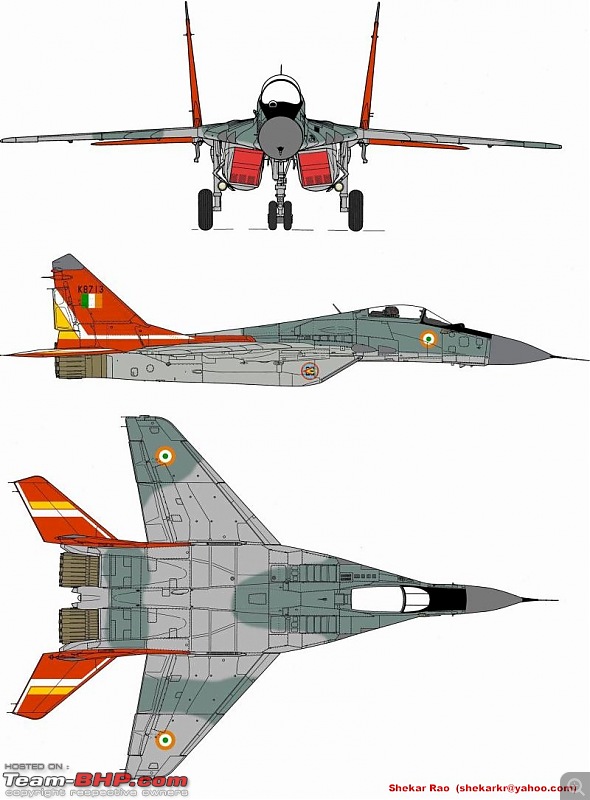
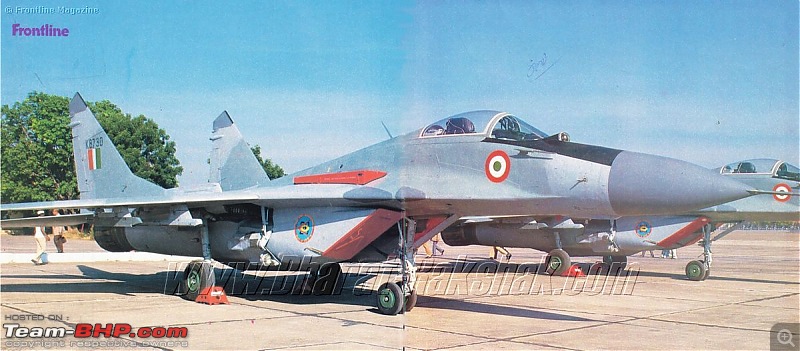
IAF went on to order 70 of these twin engined fighters. Pune became the first home for these , with 2 squadrons - no. 28, "The First Supersonics" , and no. 47, "The Black Archers". A third squadron formed, in Adampur , no. 223.
Dimensions and weights:
Length: 17.32 m (56 ft , 10 in)
Wingspan: 11.4 m (37 ft 3 in)
Height: 4.73 m (15 ft 6 in)
Wing area: 38 m² (409 ft²)
Empty weight: 10,900 kg
Loaded weight: 15,240 kg (33,730 lb)
Max. takeoff weight: 18,000 kg (44,100 lb)
Powerplant: 2 × Klimov RD-33 afterburning turbofans, bypass ratio 0.3 , convergent-divergent nozzles
5,100 kgf (50.9kN , 11,110 lbf) each
8,300 kgf (81.4 kN, 18,300 lbf) each
Fuel capacity: 4365 litres internal
1500 litres centre-line drop tank
1100 litres x 2 wing drop tanks
Performance
Maximum speed: Mach 2.35 (2,480 km/h, 1,520 mph)
At low altitude: Mach 1.25 (1,500 km/h, 930 mph)
Range:
1,500 km (790 nmi, 930 mi) with maximum internal fuel
2,100 km (1300 mi) with external drop tanks
Service ceiling: 18,000 m (59,100 ft)
Rate of climb: initial 330 m/s average 109 m/s 0–6000 m[188] (65,000ft/min)
Minimum take off run : 240 metres
Minimum landing run : 600 metres
Sustained turn rate : 22º/sec
Instantaneous turn rate : 28º/sec
Shortest turn radius : 300m at ~450km/h
Maximum G-load:
+9G/-3.5G subsonic (upto ~ Mach 0.85)
+7G supersonic
Design points :
The MiG-29 is primarily a single seat fighter, designed to operate from forward areas , scramble and attack incoming aircraft, or provide air cover for CAS (Close Air Support) aircraft in the vicinity.
The wedge type intake ducts are canted outward approx 8º. They feature ramps to contain the shockwave at supersonic speed. Intakes have hydraulic door that shuts close for ground operation ; the engine breathes through spring-loaded intake grilles on the upper LERX surface, that open when the main inlet door shuts. Door open/shut operation is automatic, triggered by engine start-up and weight on wheels sensors. When the sensors detect weight on wheels with engine running, the doors shut close by hydraulic action. Opening starts when at rotation, weight is "off" the wheels. When landing, the door shuts again when main wheels touch down.
Although this restricts air flow, the MiG-29 can run at upto 800 km/h with the upper louvres alone (with main intake door closed), allowing for emergency operation in case of failure.
The twin large tail fins are placed on LERX booms, and canted outward approx 4º. Upper lip of tail fins is clipped in common Soviet fashion. Tail fins feature RWR (radar warning receiver) and IFF equipment.
Tail fins feature leading edge extension fences containing infra-red (IR) (flares) and radar countermeasures (chaff) cartridges. Each fence holds up to 30 cartridges. In MiG-29M/K and MiG-35, fences deleted and countermeasures moved to spine ahead of the air-brake.
Wings are fixed with 40º leading edge, feature leading edge slats that deploy automatically. Trailing edge has inboard flaps for landing/take off, with ailerons outboard. MiG-29M, K and MiG-35 feature larger wing area, with larger flaps and rounded wing-tip containing ECM equipment.
All moving tail planes (stabilators) perform roll control at high speeds, have 60º leading edge. MiG-29M features larger stabilator, with dog-tooth and extended area.
MiG-29 employs a braking parachute for landing, housed in a dome between engines at the rear fuselage. Air brakes are split with dorsal and ventral surfaced. MiG-29M/K and MiG-35 delete split air brake in favour of single dorsal airbrake and twin parachutes in tail fairing.
Nose gear has 2 wheels with mudguard , retracting backward between engines. Main gear has single wheel, rotating flat and nested in LERX and engine duct. Each gear has a single landing/taxi light.
Pilot sits under one piece bubble canopy, hinged to the rear. Windscreen is also one piece, with no reinforcing metal frame, allowing for unprecedented visibility for Russian fighters. Ejection seat is Zvezda K-36D, regarded by many as the best ejection seat in the world, capable of 0/0 ( zero speed, zero altitude ejection). Rear view facilitated by 3 mirrors in cockpit, attached to windscreen bow. Rear crew/instructor in the two seat MiG-29UB gets a periscope to get a view of forward hemisphere.
The MiG-29 has a very short take off roll due to high lift and high thrust. All controls are hydraulic, with no fly by wire. Handling is benign - resistance to enter normal spins, very resistance to flat spins, recovers to stable flight on releasing controls. Airframe displays exceptional agility despite being a static stable design with no fly-by-wire controls. The MiG-29 can maintain controlled flight up to some 30-35º alpha (AoA) but is restricted to 26º AoA (angle of attack) under regular flight, to prevent stalling and departure from controlled flight. For aerobatic displays or combat manoeuvres, the AoA limitation can be overridden by a switch on the joystick, removing the AoA limitation, which allows the pilot to do this :
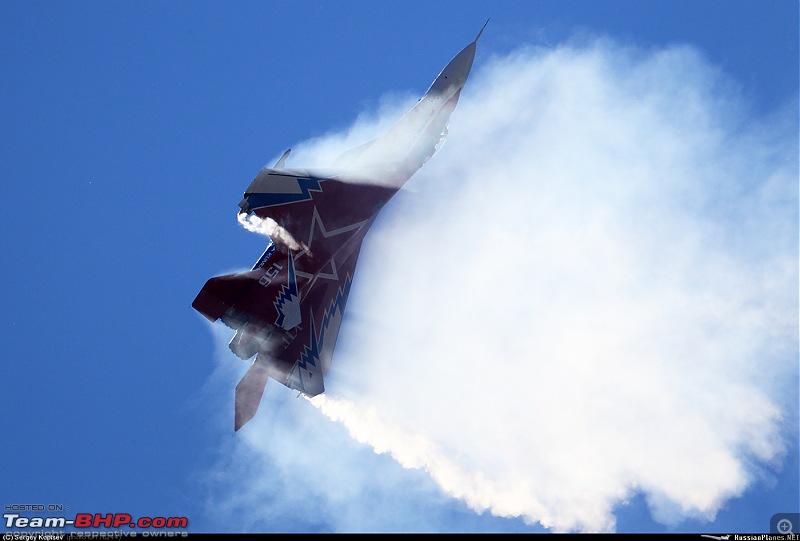
- Joined
- Oct 13, 2015
- Messages
- 7,494
- Likes
- 17,197
MiG-29 pulling a high alpha manoevre - AoA looks like ~120º !
The RD-33 engines can go from idle to full afterburner in 4 seconds, among the best in the world. Engine is very resistance to airflow disturbances, can operate even in zero airspeed as witnessed by the Pugachev's Cobra or the tail slide maneouvres, that demonstrate engine robustness to disturbed airflow conditions. Major issues with engines are short life and short time between overhauls ( 350 hours ), smoky exhaust and high fuel consumption.
While the radar range was nominally held as 100-110km search, the big news was the IRST - Infra-red search and track system. With the radar off or on standby, the IRST could be used to search and track targets as far as 50km in good weather conditions, to launch missiles at a target without emitting any signal - that could warn the target it's under attack. In practice due to AWACS, sneaking up to western aircraft is hard to do, but in absence of AWACS, a MiG-29 could sneak up to and shoot down other aircraft in sort of silent mode.
Later upgrades to the radar achieve better range and resolution, multiple target tracking capability and thus can use BVR/medium range missiles to greater effect.
The RD-33 engines can go from idle to full afterburner in 4 seconds, among the best in the world. Engine is very resistance to airflow disturbances, can operate even in zero airspeed as witnessed by the Pugachev's Cobra or the tail slide maneouvres, that demonstrate engine robustness to disturbed airflow conditions. Major issues with engines are short life and short time between overhauls ( 350 hours ), smoky exhaust and high fuel consumption.
While the radar range was nominally held as 100-110km search, the big news was the IRST - Infra-red search and track system. With the radar off or on standby, the IRST could be used to search and track targets as far as 50km in good weather conditions, to launch missiles at a target without emitting any signal - that could warn the target it's under attack. In practice due to AWACS, sneaking up to western aircraft is hard to do, but in absence of AWACS, a MiG-29 could sneak up to and shoot down other aircraft in sort of silent mode.
Later upgrades to the radar achieve better range and resolution, multiple target tracking capability and thus can use BVR/medium range missiles to greater effect.
- Joined
- Oct 13, 2015
- Messages
- 7,494
- Likes
- 17,197
MiG-29 variants :
Prototypes and early production units:
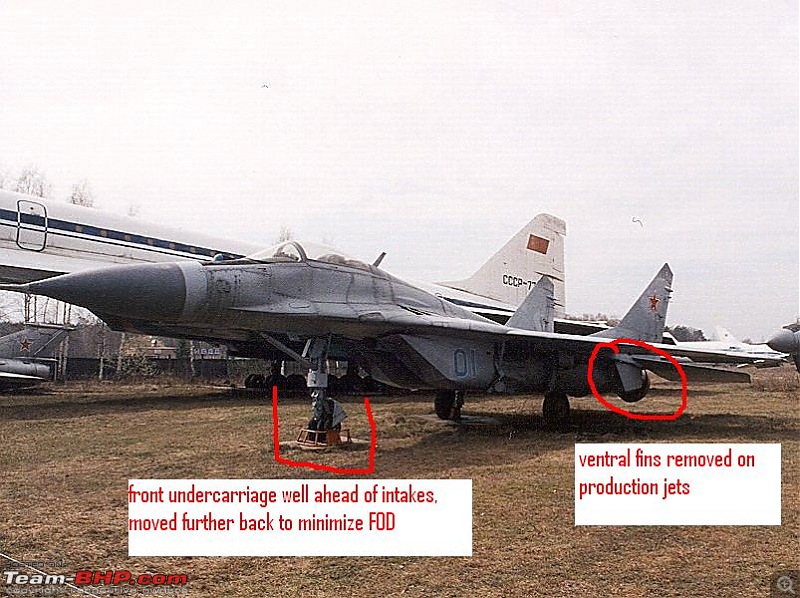
Some of the early production units had ventral fins, similar to the Su-27. Subsequent production deleted these. The nose gear was moved further back to reduce chance of FOD - Foreign Object Damage, and the strut retracts backward between the intake ducts.
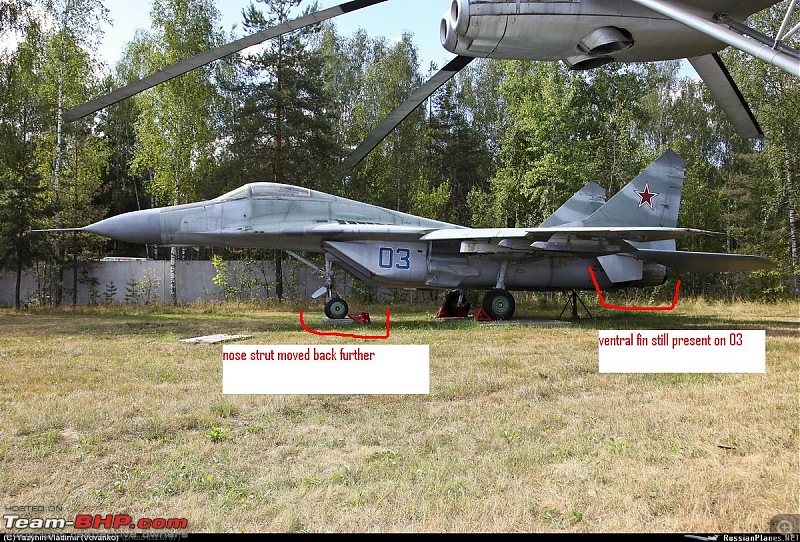
Production jets:The early MiG-29 was designated MiG-29B, Fulcrum A, with the 2 seat trainer MiG-29UB, as Fulcrum B.
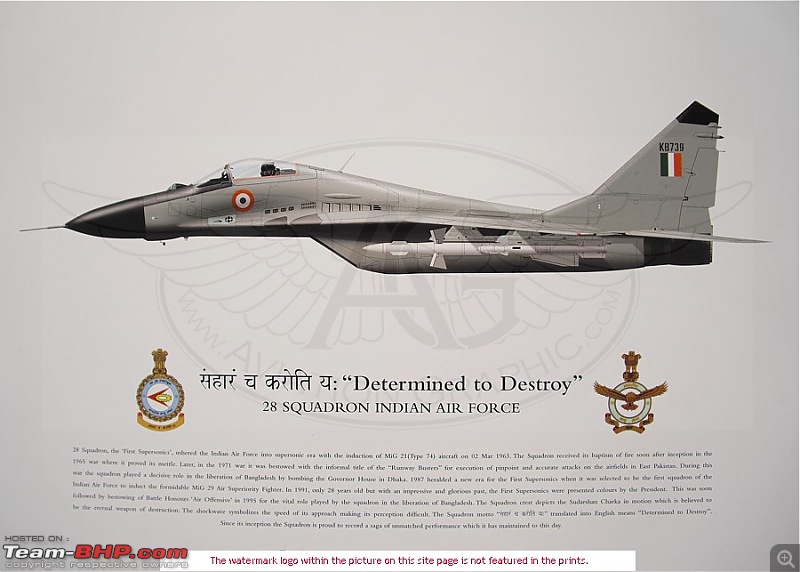
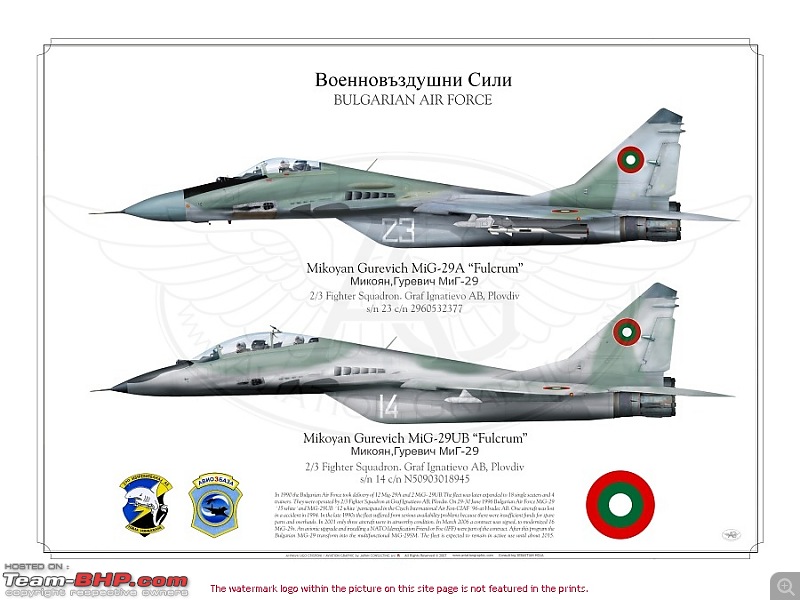
Prototypes and early production units:

Some of the early production units had ventral fins, similar to the Su-27. Subsequent production deleted these. The nose gear was moved further back to reduce chance of FOD - Foreign Object Damage, and the strut retracts backward between the intake ducts.

Production jets:The early MiG-29 was designated MiG-29B, Fulcrum A, with the 2 seat trainer MiG-29UB, as Fulcrum B.


Articles
-
India Strikes Back: Operation Snow Leopard - Part 1
- mist_consecutive
- Replies: 9
-
Aftermath Galwan : Who holds the fort ?
- mist_consecutive
- Replies: 33
-
The Terrible Cost of Presidential Racism(Nixon & Kissinger towards India).
- ezsasa
- Replies: 40
-
Modern BVR Air Combat - Part 2
- mist_consecutive
- Replies: 22
-
Civil & Military Bureaucracy and related discussions
- daya
- Replies: 32


